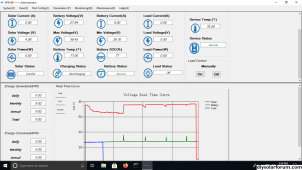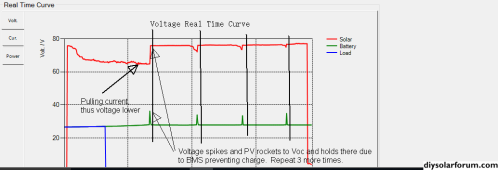DrBourne
New Member
Hey Guys,
I was hoping that someone could give me an idea as to these battery voltage spikes. No inverter in play at the time. see image below.
The 'Charging Status' reading "Not Charging" was there before I disconnected the PV. But, I could be wrong. Should have left it on before taking the screenshot.
When I use the inverter(24V 3000W) it would beep and shut off momentarily. Not under a heavy load, under 500W. This makes me afraid to use it to power my computers, which is my primary reason for setting it up.
gear;
eight 100W panels wired 4s2p
Epever Tracer 4215BN controller
Wzrleb 24v 3000W inverter
two 12.8V 200Ah in series
settings;
Maximum battery voltage today: 36.45V
Minimum battery voltage today: 26.7V
Battery type: USER_DEFINED
Battery capacity: 200AH
Over voltage disconnect voltage: 29.4V
Charging limit voltage: 28.8V
Over voltage reconnect voltage: 28.4V
Equalize charging voltage: 28.6V
Boost charging voltage: 28.6V
Float charging voltage: 27.4V
Boost reconnect charging voltage: 27V
Low voltage reconnect voltage: 24.8V
Under voltage recover voltage: 24V
Under voltage warning voltage: 23.2V
Low voltage disconnect voltage: 21.6V
Discharging limit voltage: 21.6V
Battery rated voltage: 24V
Default load on/off in manual mode: OFF
Equalize duration: 0 min
Boost duration: 60 min
Thanks,
Dale


I was hoping that someone could give me an idea as to these battery voltage spikes. No inverter in play at the time. see image below.
The 'Charging Status' reading "Not Charging" was there before I disconnected the PV. But, I could be wrong. Should have left it on before taking the screenshot.
When I use the inverter(24V 3000W) it would beep and shut off momentarily. Not under a heavy load, under 500W. This makes me afraid to use it to power my computers, which is my primary reason for setting it up.
gear;
eight 100W panels wired 4s2p
Epever Tracer 4215BN controller
Wzrleb 24v 3000W inverter
two 12.8V 200Ah in series
settings;
Maximum battery voltage today: 36.45V
Minimum battery voltage today: 26.7V
Battery type: USER_DEFINED
Battery capacity: 200AH
Over voltage disconnect voltage: 29.4V
Charging limit voltage: 28.8V
Over voltage reconnect voltage: 28.4V
Equalize charging voltage: 28.6V
Boost charging voltage: 28.6V
Float charging voltage: 27.4V
Boost reconnect charging voltage: 27V
Low voltage reconnect voltage: 24.8V
Under voltage recover voltage: 24V
Under voltage warning voltage: 23.2V
Low voltage disconnect voltage: 21.6V
Discharging limit voltage: 21.6V
Battery rated voltage: 24V
Default load on/off in manual mode: OFF
Equalize duration: 0 min
Boost duration: 60 min
Thanks,
Dale





